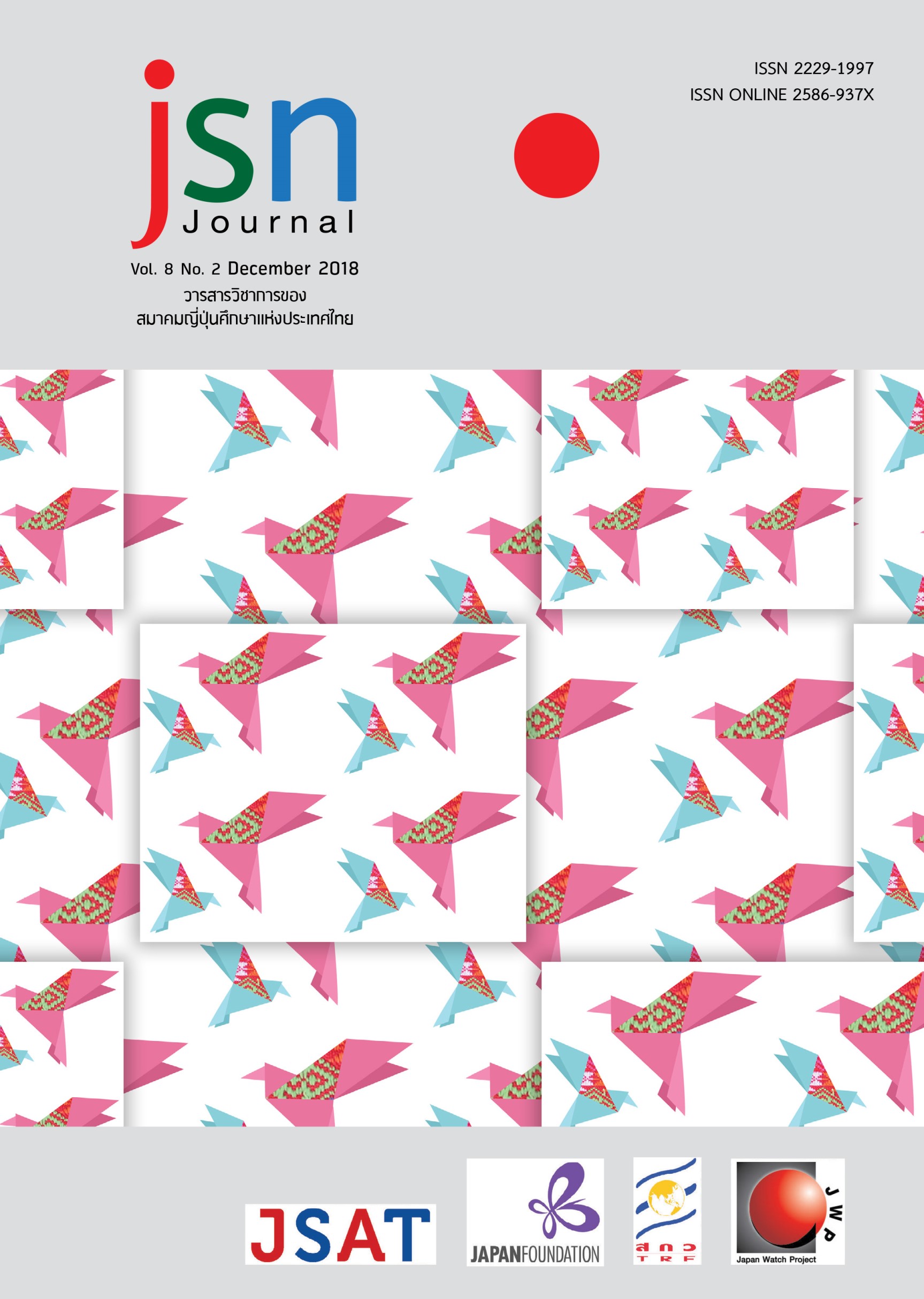Recognition of English loan Words by Thai Students of Japanese
Main Article Content
Abstract
This research examined the comprehension and error patterns related to loan words in Japanese vocabulary learning of 106 third-year students majoring in Japanese from 4 universities in Thailand. Students were divided into good and poor groups (21:85) by their Japanese Language Proficiency Test Results. They were asked to translate A) 20 English words with their equivalent loan words B) 20 loan words with the original English words C) 6 loan words of Japanese innovations and other European origin with the original English words. Descriptive and Inferential Statistics were used to analysis the data. Qualitative analysis was applied to describe what types of errors students made. It revealed that translation correctness or comprehensibility of English words to loan words were higher than the other two types of loan words in both groups of students (good group: x̄ = 2.55, 2.48, 1.87, poor group x̄ = 2.18, 2.16, 1.59 respectively). Students faced problems in the translation of English words ending with schwa sounds. The error patterns in identifying the loan words of students related to the types of loan words.
Article Details
ข้อความและข้อคิดเห็นต่างๆ ในบทความเป็นของผู้เขียนบทความนั้นๆ ไม่ใช่ความเห็นของกองบรรณาธิการหรือของวารสาร jsn Journal
References
Arabski, J. (2006). Language Transfer in Language Learning and Language Contact. In Arabski, J.(ed) Cross-linguistic Influences in the Second Language Lexicon. Clevedon: Multilingual Matters.
Daulton, F. E. (1998). Japanese Loanword Cognates and the Acquisition of English Vocabulary. The Language Teacher, 20(1), 17-25.
__________ (1999). List of High-Frequency Baseword Vocabulary for Japanese EFL Students. The Internet TESL Journal, Vol. V. No. 11.<http://iteslj.org/lists/Daulton-Baseword Vocabulary.html>
__________ (2001). Book Reviews: A Dictionary of Loanword Usage; Tuttle New Dictionary of Loanwords in Japanese. JALT Journal, 23(2), 274-276.
] __________ (2008). Japan’s Built-in Lexicon of English-based Loanwords. Clevedon & Philadelphia: Multilingual Matters.
Habein, Y.S. (1984). The history of the Japanese written language. Tokyo: University of Tokyo Press.
Igarashi, Y. (2007). The Changing Role of Katakana in the Japanese Writing System: Processing and Pedagogical Dimensions for Native Speakers and Foreign Learners. A Dissertation Submitted in Partial Fulfillment of the Requirements for the Degree of Doctor of Philosophy in the Department of Linguistics. University of Victoria.
Irwin, M. (2011). Loanwords in Japanese. Amsterdam: John Benjamins Publishing Company.
Kageyama, T. & Kishimoto, H. (2016). Handbook of Japanese Lexicon and Word Formation. Walter de Gruyter GmbH & Co KG.
Kay, G. (1995). English loanwords in Japanese. World Englishes, 14 (1), 67-76.doi:10.1111/j.1467-971X.1995.tb00340.x
Kimura, M. (1989). The effect of 5 Japanese loanwords on the acquisition of the correct range of meanings of English words. Master’s Thesis, Brigham Young University, Department of Linguistics.
Kitanaka, K. (2007). Vocabulary Recognition, English Loan Words and English Learners. A Dissertation Submitted in Partial Fulfillment of the Requirements for the Degree of Master of Arts in Interdisciplinary Studies. California State University, Long Beach.
Labrune, L. (2002). The prosodic structure of simple abbreviated loanwords in Japanese: A constraint-based account. Onsei Kenkyu [Journal of the Phonetic Society of Japan] 6(1): 98–120.
Loveday, L. J. (1996). Language contact in Japan: A sociolinguistic history. Oxford, UK: Clarendon Press.
Moeran, B. (1989). Language and Popular Culture in Japan. Manchester: Manchester University Press, 1989.
Olah, B. (2007). English loanwords in Japanese: Effects, attitudes and usage as a means of improving spoken English ability, Bunkyo Gakuin Daigaku Ningen-gakubu Kenkyuu Kiyo 9(1), 177-188.
Saiga, H. (1955). Sougou zasshi no katakanago [Katakana words in general magazines]. Gengo Seikatsu [Language Life], 46, 37-45.
Scherling, J. (2015). Japanizing English: Anglicisms and their impact on Japanese. BoD – Books on Demand.
Shibatani, M. (1990). The Language of Japan. Cambridge University Press.
Stanlaw, J. (2004). Japanese English: Language and Culture Contact. Hong Kong: Hong Kong University Press.
Thompson, I. (1990). Japanese Speakers, In Michael Swan and Bernard Smith (Eds.), Learner English: A teacher’s guide to interference and other problems. Cambridge: Cambridge University Press.
Tomoda, T. (1999). The Impact of Loan-Words on Modern Japanese. Japan Forum, 11(1), 231-253.
Tsujimura N. (1996). An Introduction to Japanese Linguistics. Malden, Massachusetts: Blackwell.
Van Benthuysen, R. V. (2010). Japanese ESL Learners’ Acquisition of English Loanword Cognates: Difficulties Due to Semantic, Phonological, and Orthographic Factors. Bunkyo Gakuin Daigaku Gaikokugo Gakubu Bunkyo Gakuin Tankidaigaku Kiyo, 10 (2010).


